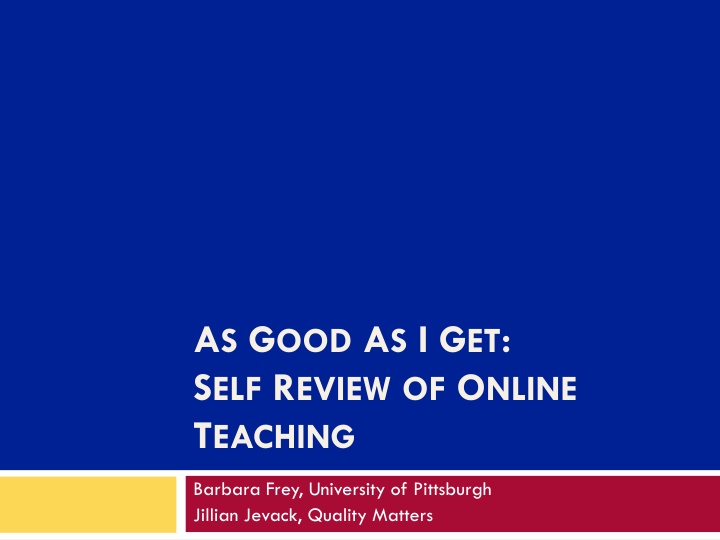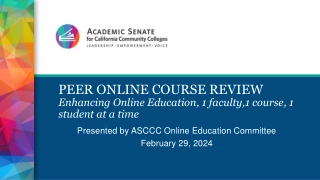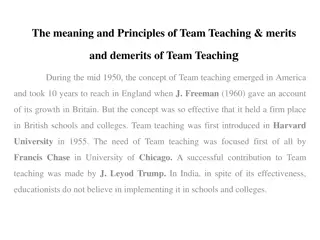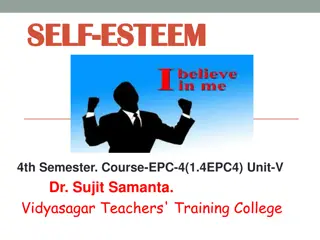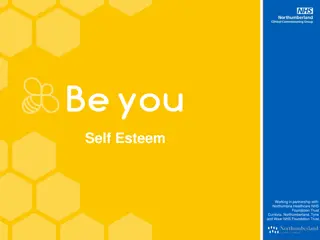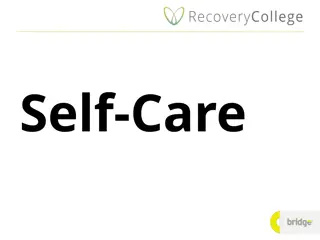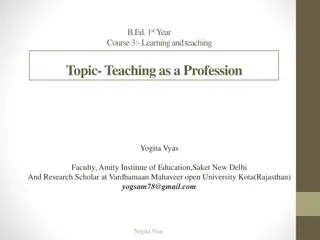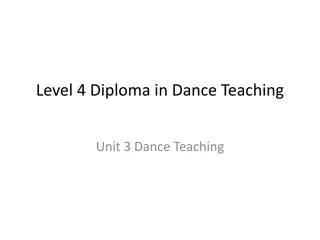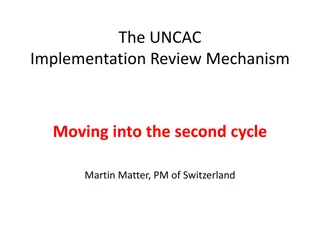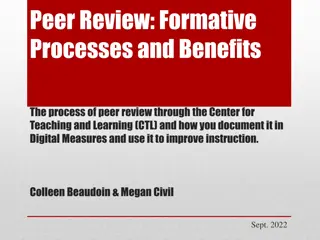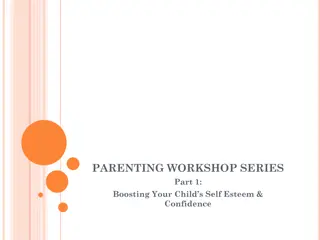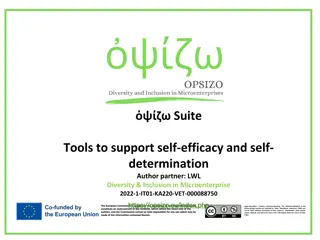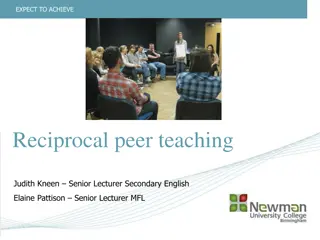Enhancing Online Teaching Through Self-Review: Challenges and Benefits
Explore the self-review process of online teaching, including identifying challenges, benefits, and different types of reviews. Learn about developing an effective review guide, promoting collegiality, and facilitating professional development in online teaching. Discover the components of a review guide and how to conduct a mock review for continuous improvement.
Download Presentation

Please find below an Image/Link to download the presentation.
The content on the website is provided AS IS for your information and personal use only. It may not be sold, licensed, or shared on other websites without obtaining consent from the author.If you encounter any issues during the download, it is possible that the publisher has removed the file from their server.
You are allowed to download the files provided on this website for personal or commercial use, subject to the condition that they are used lawfully. All files are the property of their respective owners.
The content on the website is provided AS IS for your information and personal use only. It may not be sold, licensed, or shared on other websites without obtaining consent from the author.
E N D
Presentation Transcript
AS GOOD AS I GET: SELF REVIEW OF ONLINE TEACHING Barbara Frey, University of Pittsburgh Jillian Jevack, Quality Matters
Learning Objectives Identify challenges and benefits institutions face in reviewing online teaching Compare and contrast key components of a review guide of online teaching Develop a process that promotes collegiality, respect, and professional development
Agenda Review literature on evaluation of online teaching Complete an individual mock review using the Self Review of Online Teaching Guide Discuss strengths and areas for improvement in the Self Review of Online Teaching Guide Share recommendations for initiating an effective review of teaching process
Different Types of Review Self Student Administrative Peer
Challenges Developing an instrument that applies to the online environment and addresses delivery and not design Gaining faculty buy-in to the process Conducting the process efficiently Your challenges?
Benefits Quality learning experiences for students Support for faculty professional development Educate the institutional community about online learning Demonstrate quality to accrediting agencies Your benefits?
7 Components of Review Guide Encourages contact with students and faculty Develops reciprocity and cooperation Encourages active learning Gives prompt feedback Emphasizes time on task Communicates high expectations Respects diverse talents and ways of learning 1. 2. 3. 4. 5. 6. 7.
Mock Review If you teach an online or blended course, complete the Guide based on your course If you do not teach an online or blended course, complete the Guide by taking on the persona of a typical faculty member at your institution Note your questions and comments for further discussion
Refining the Review Guide Here s what our faculty said: Overall: add sections for Challenges and Resources Principle 1: define regular basis and timely manner ; question of office hours What are your thoughts/suggestions?
Process Recommendations Involve faculty in customizing the guide and outlining the review process Emphasize continuous improvement and professional development Align the self review process with end of course reviews Consider using the guide for peer reviews after a reasonable time of testing and feedback, possibly with MyCR Your recommendations?
Related Presentations Seven Principles and Eight Standards: Alignment Toward Quality Instruction Katherine Hitchcock and Michelle Franz (Tuesday 4:20-5:10 PM) Evaluating Instructor Delivery: A System Based on QM Principles Stacey Bybee and Kate Bowersox (Poster) QM Standards and Principles of Good Teaching Tena B. Crews and Kelly Wilkinson (Poster)
Contact Jillian Jevack jillian.jevack@qualitymatters.org
References Academic Impressions (2013). Evaluating online faculty. Retrieved from http://www.academicimpressions.com/conference/evaluating-online-faculty#. Eskey, M. T., & Roehrich, H. (2013). A faculty observation model for online instructors: Observing faculty members in the online classroom. Online Journal of Distance Learning Administration, 16 (2). Retrieved from http://www.westga.edu/~distance/ojdla/summer162/eskey_roehrich162.html. Mandernach, B. J., Donnelli, E., Dailey, A., & Schulte, M. (2005). A faculty evaluation model for online instructors: Mentoring and evaluation in the online classroom. Online Journal of Distance Learning Administration, 8(3). Retrieved from http://www.westga.edu/~distance/ojdla/fall83/mandernach83.htm. Tobin, T. J. (2004). Best practices for administrative evaluation of online faculty. Online Journal of Distance Learning Administration, 7(2). Retrieved from http://www.westga.edu/~distance/ojdla/summer72/tobin72.html. Tu, C. (2004). Applications of formative and descriptive evaluations in online training. Performance Improvement, 43(5).
Academic Impressions (2013) Evaluating Online Faculty Conference
Eskey and Roehrich (2013) Described how the Faculty Online Observation (FOO) method is used to review online adjunct faculty teaching at Park University Challenges the need to develop appropriate evaluation methods that are relevant, specifically, to the online environment New instructors tended to be more receptive to the process, whereas more experienced faculty showed more resistance Original process (OIES) was resource-intensive; FOO streamlined Benefits Ensure students are being provided with a quality learning experience Supporting faculty in their professional development as online instructors
Mandernach, Donnelli, Dailey, & Schulte (2005) Described how the Online Instructor Evaluation System (OIES) at Park University served the purposes of mentoring and evaluation, providing both formative and summative reviews Challenges Need for models geared specifically to the unique demands, expectations and requirements of modern online learning Departmental leaders who may be performing evaluations may need to be educated on the differences between traditional and online classroom evaluations, especially if they have not had experience teaching online Able to separate design from delivery because standardized curriculum is used Benefits Educate the university community about best practices of online learning
Tobin (2004) Sought to identify behaviors that indicate competence in online teaching Compared and contrasted the experience of a traditional classroom observation/evaluation with an online classroom observation/evaluation Challenges How often to visit the online classroom? Some questions on traditional classroom evaluation tool may not apply to the online classroom What might be considered good in the traditional classroom may be considered bad in the online classroom Benefits Demonstrate quality to accrediting agencies
Tu (2004) Described how peer and student evaluation can be integrated Challenges Many institutions try to apply face-to-face criteria to online Need for peer evaluators to be trained Benefits More valuable to faculty than separate peer and student evaluations
